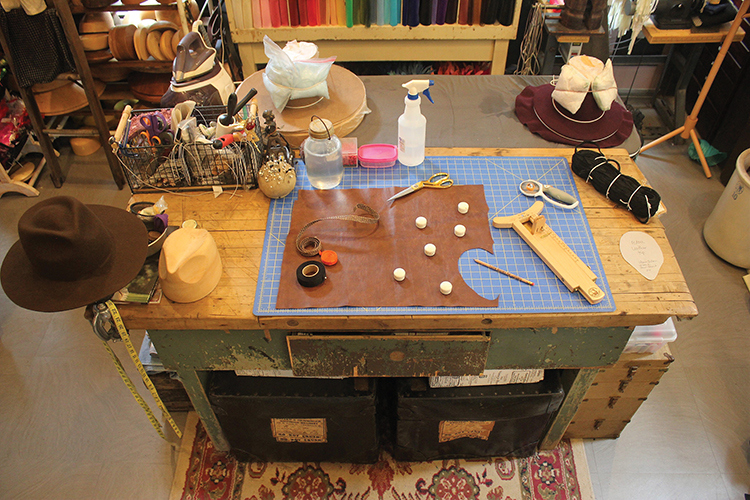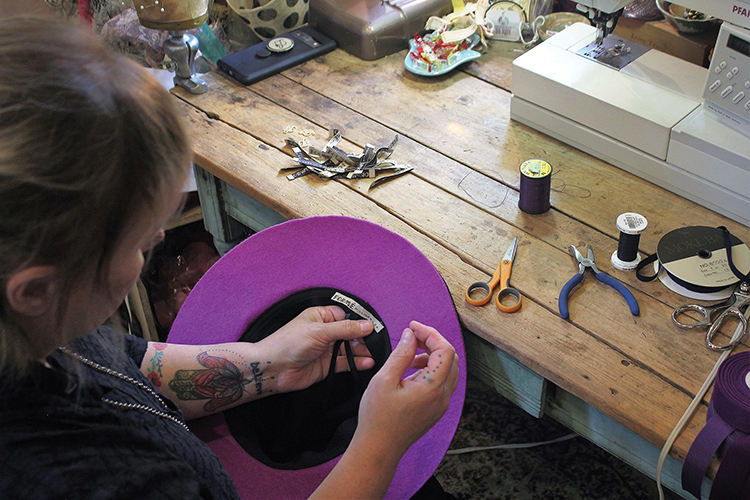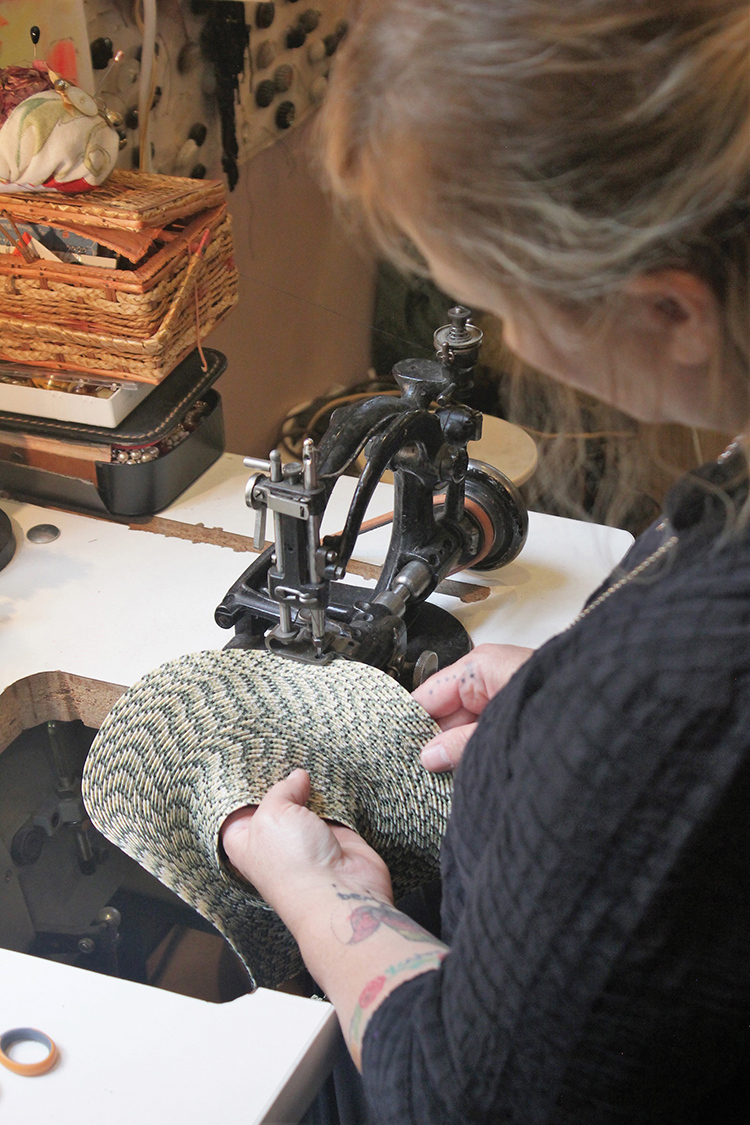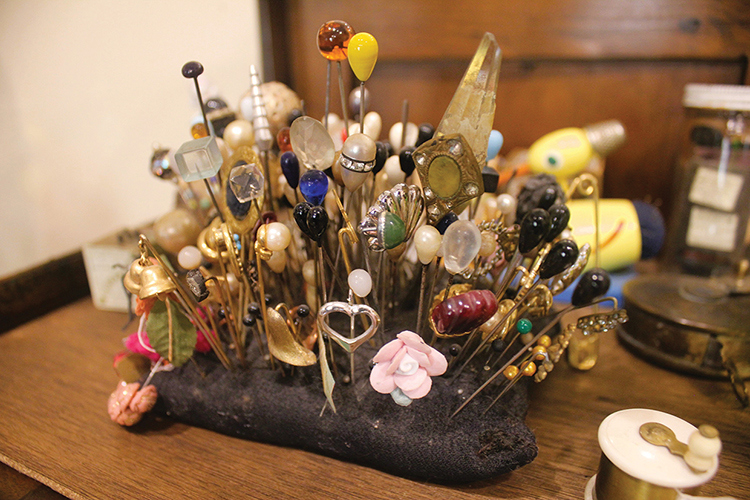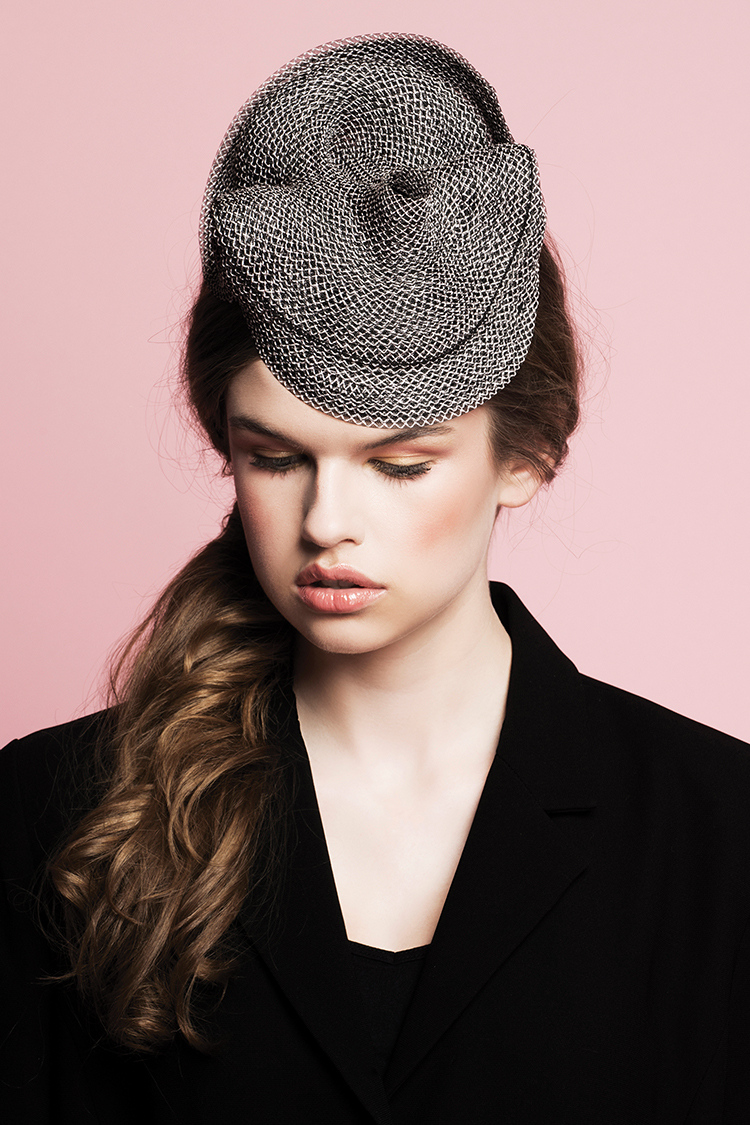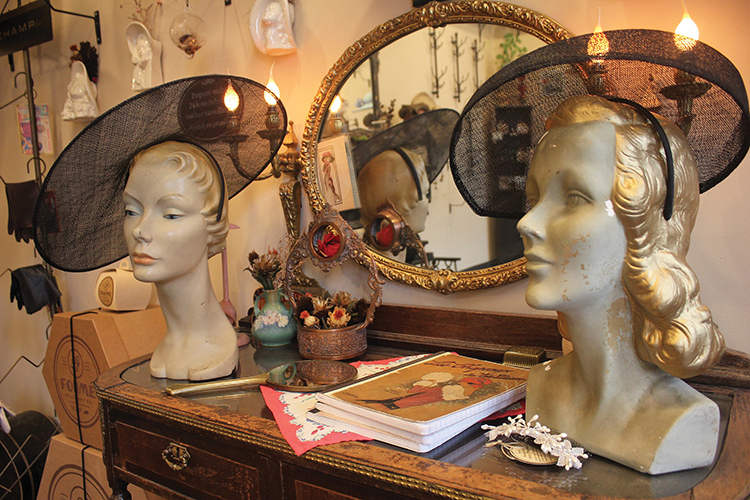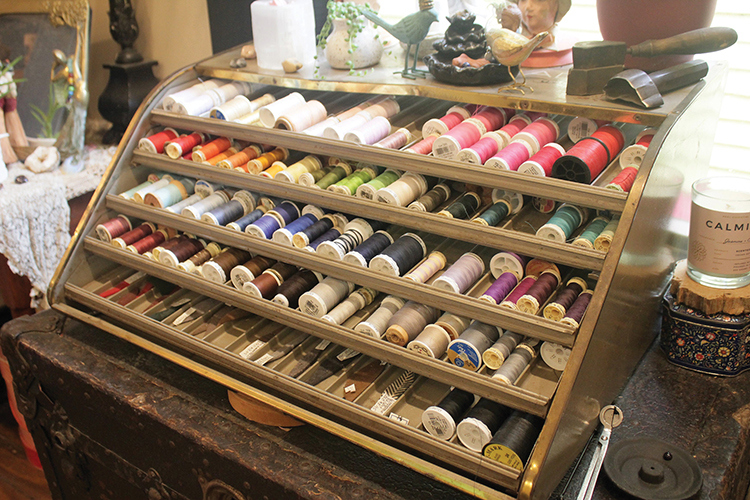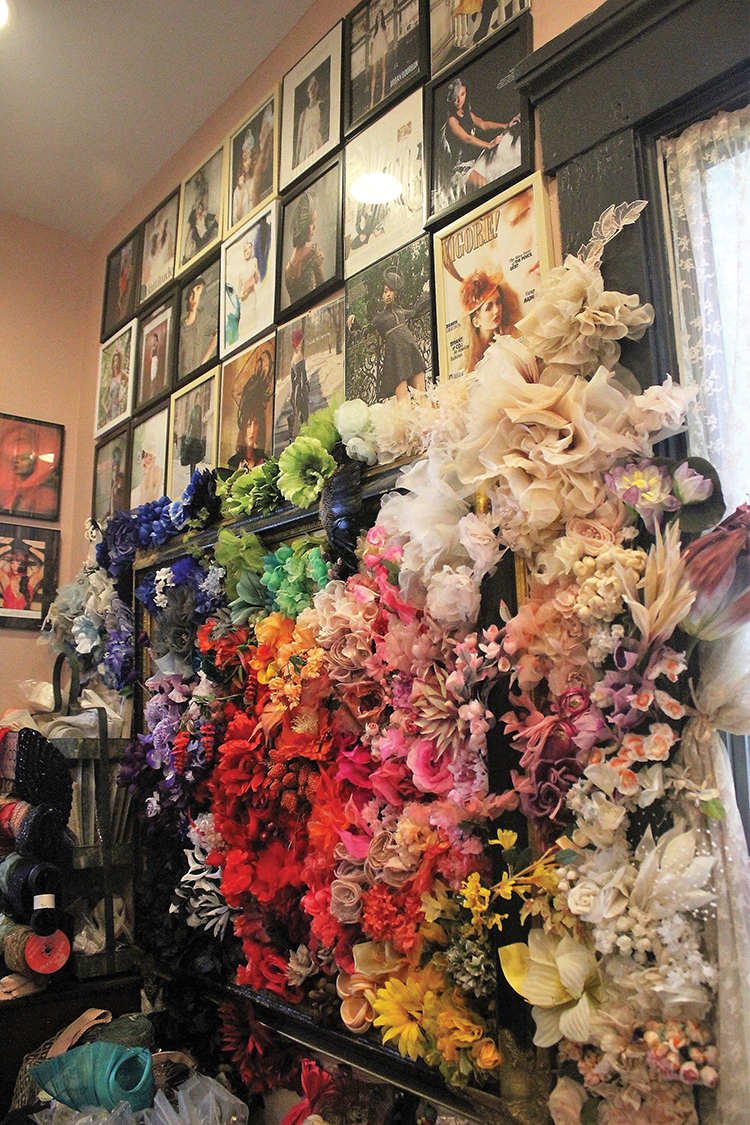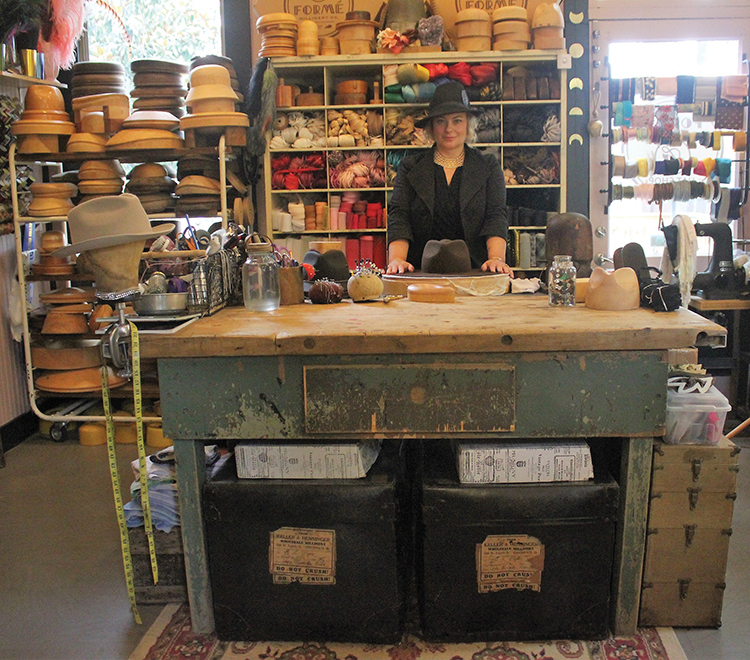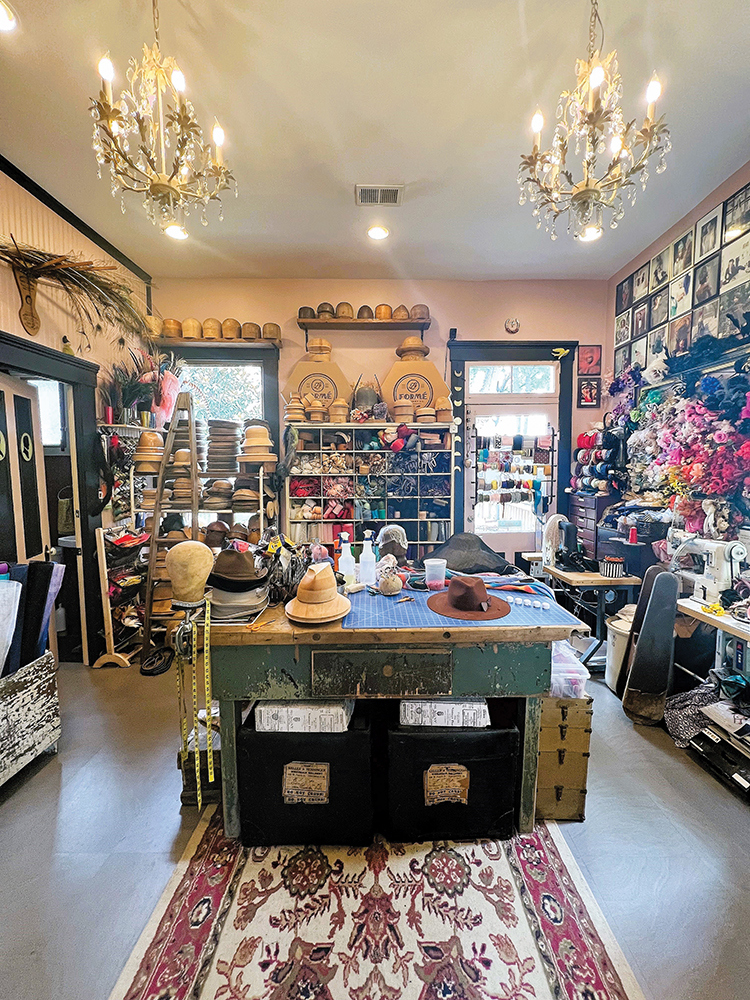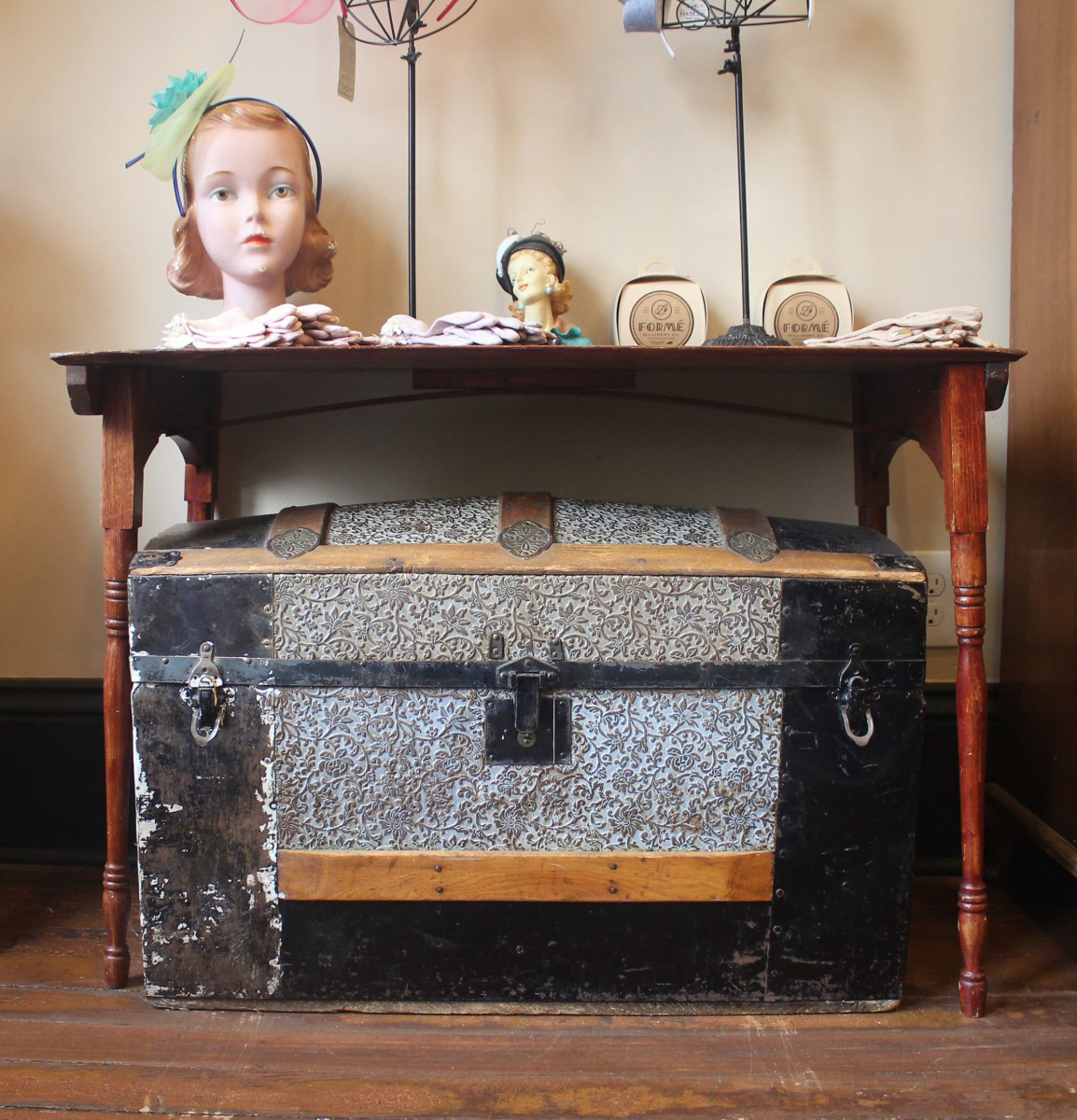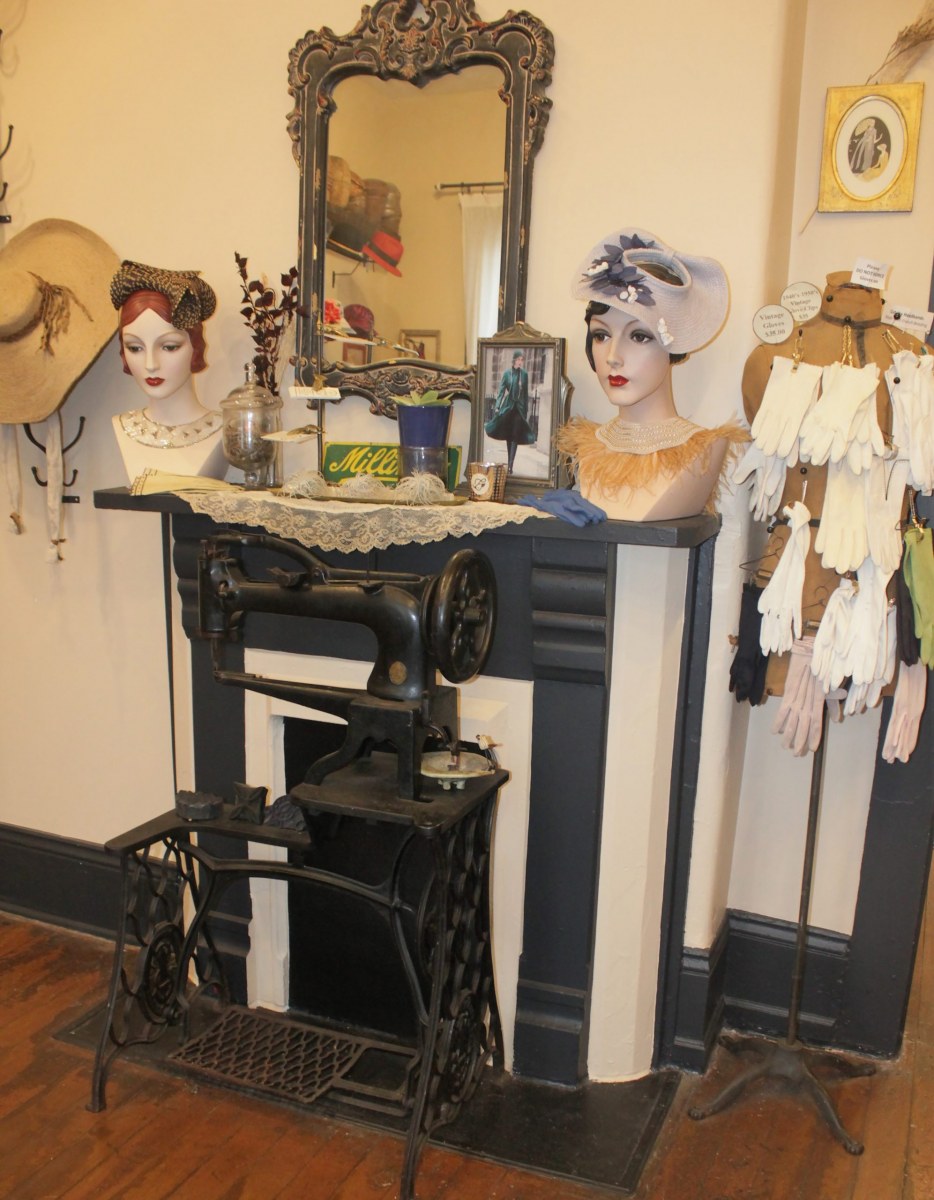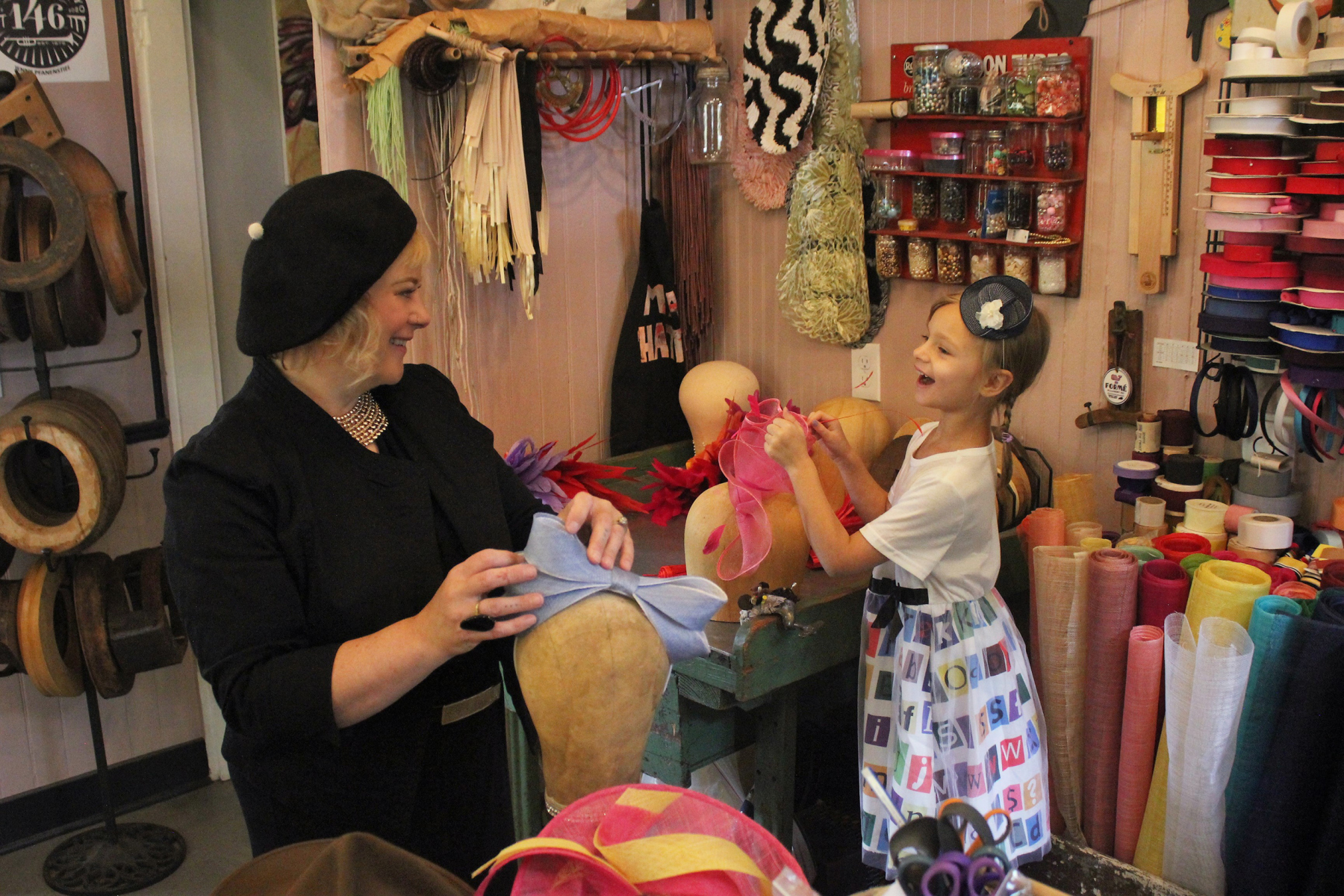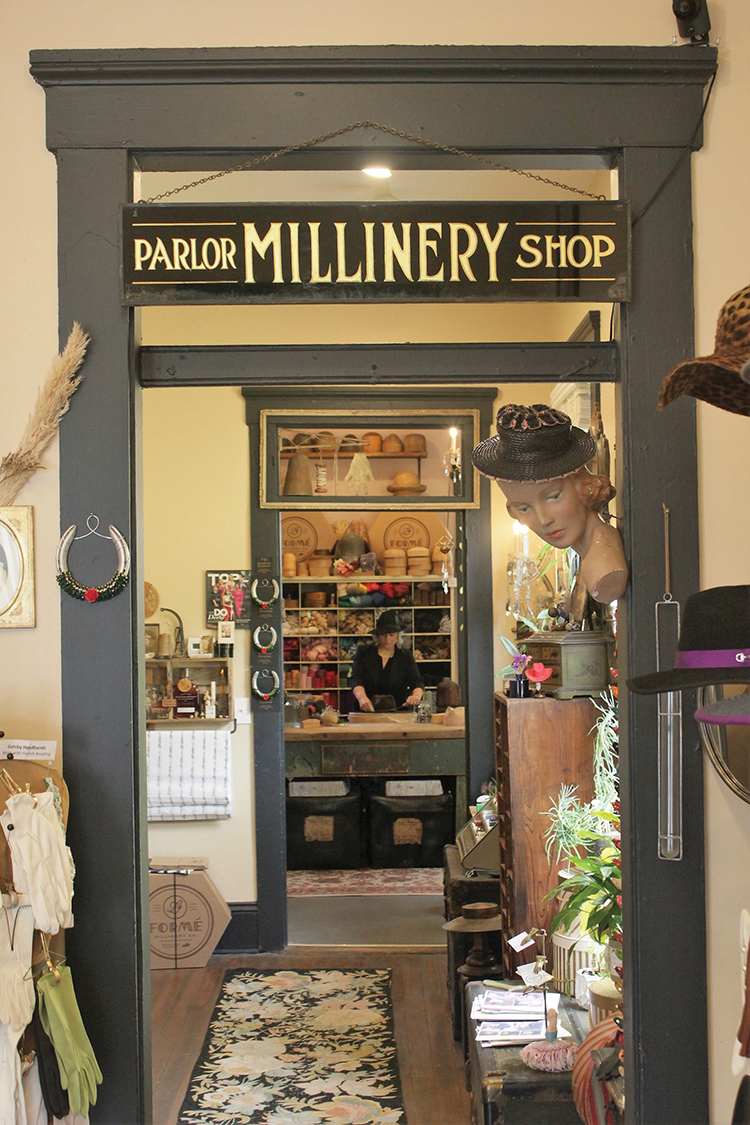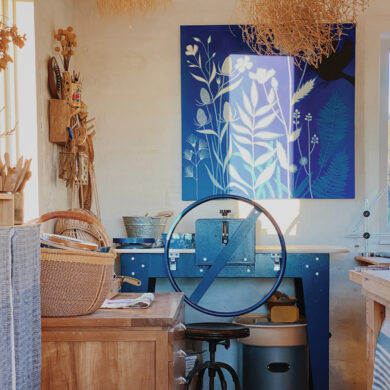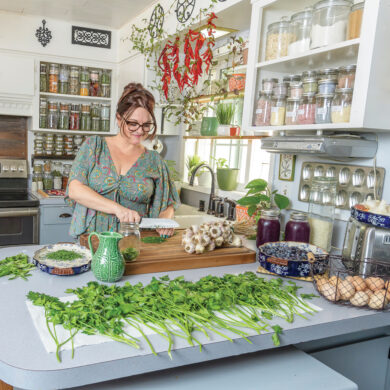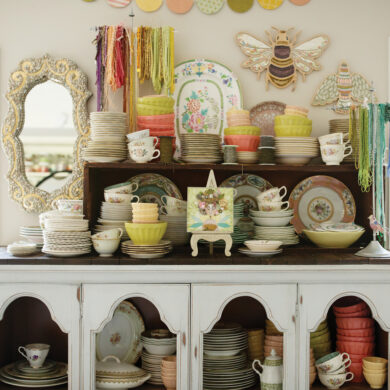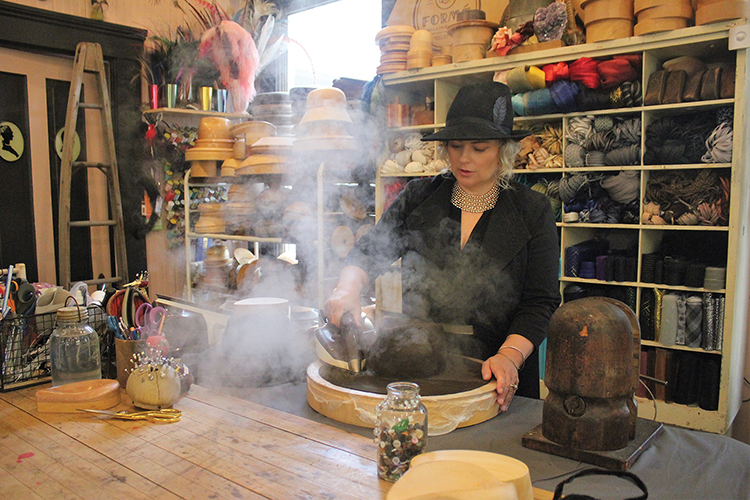
Never would I have imagined 14 years ago that sitting in my basement in Chicago making hats as a hobby would lead me to where I am today. It all started when I was 5 years old, when my mother taught me how to cross-stitch. Growing up, she sewed everything for my sister and me, from the clothes we wore to the dolls we played with. In high school, I lived in a tiny mountain town in Colorado and became great friends with a woman who was from England who made costumes for the local theater. She taught me so much about wardrobe construction and to not be afraid to experiment with materials and techniques in my work. This led me to study fashion design at the Colorado Institute of Art in Denver.
As a young girl, I was a ballerina, and I loved the idea of making costumes for the ballet. I did this for a couple of years, then decided it was time for me to move on to other experiences. After graduating, I packed up and moved to Chicago, where I created costumes for Cirque du Soleil, movies and commercials — and even a Grammy dress for Margaret Cho. I loved what I did, but I knew something was missing. One night, I was attending a lecture where a woman was talking about an age-old technique of blocking hats where she molded material over old wooden hat forms. Being an old soul myself, I loved how things were made years ago, and I wanted to learn more.
I ended up visiting Australia, where I learned the traditional techniques of hat making. I was immediately hooked, and because I knew how to hand sew, it came quite naturally. I started collecting old hat blocks that were used to hand-make each hat, many of them dating back centuries. Part of what intrigued me about the hat-making process was collecting the old blocks. When working with them, I loved thinking about the many hands that once made a hat on that exact block: What type of person were they? Where were they from? I thought about their energy coming through the blocks and being a part of each hat.
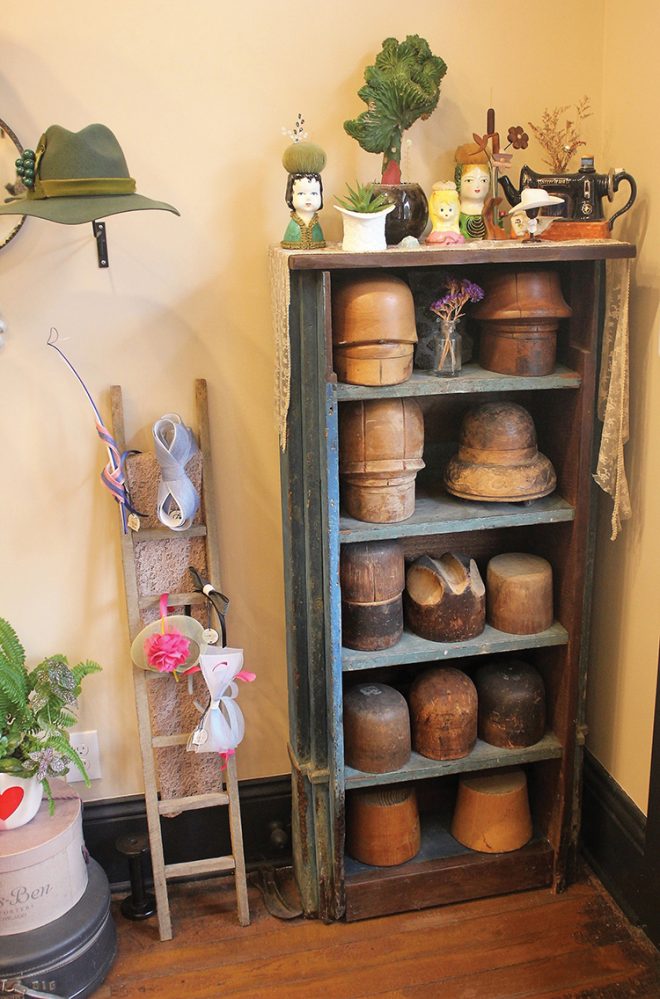
Making hats has always been about a feeling and never about just going through the motions to whip out a hat. From blocks, I started experimenting with sculpting hats. One fun fact about me is: I do not draw my designs. I find the best way for me to communicate and create what is in my head is to work with a material in my hands, forming it and allowing it to become what it wants. Never forcing an angle or shape. This allows me to create truly one-of-a-kind pieces, which my clients love.
Through my exploring, I am always keeping an eye out for old hat-making equipment and purchased a straw braid machine from the 1800s. This machine was typically used to create basic straw braid brimmed hats, though it operates very differently than your regular sewing machine. Because I was unfamiliar with how to traditionally use the machine, I started experimenting with the way the braid would sew together.
One day, I started to move my wrist and fingers as the braid was sewing together. I immediately noticed the shape change, and as I moved my wrist more or my fingers a different way, the braid moved in a different direction. I knew that I had just created something different, and thus my sculptural braided hats were born, something I have become known for throughout the world.
Let’s step back about 10 years, when I was living in Chicago. I owned a beautiful row house from 1883 with original stained-glass windows and pocket doors. I was creating hats in my basement and had transformed my dining room into a showroom where my clients would come to visit. While selling my hats at a local art fair, I met the woman who had a booth next to me who was from Kentucky. She asked if I ever thought of making hats for the Kentucky Derby. I hadn’t, so she invited me to stay with her during the Derby the following year and sell hats. I made appointments with several boutiques and sold hats from the trunk of my car. I sold out in one day and thought, “WOW: People really like hats here.”
Every year, I visited Kentucky during the Derby and rented a hotel room for two months. I would bring all my blocks and sewing machines and create hats to sell at hotels and boutiques. During this time, I fell in love with the town. The people were so nice, and I was amazed with how supportive the town was for small businesses, very different from a big city. So, once again, I packed my bags and moved to Louisville, Kentucky — this time with my husband, Bart. My goal was to have a storefront and get my hat studio out of our home. I found a 200-square-foot art studio that was among other artist studios.
I remember being so worried that I had rent to pay on a space, but I knew this was my time to run with my talent and create a name for myself.
Quickly, I grew out of my first art studio and rented something bigger in the same complex. Thinking about how many hats I must sell in a month to pay the higher rent was always lots of pressure. I made a commitment to myself that I was not looking back, and I would do whatever I needed to make this work. This was my passion, and I was confident that if I kept at it through the ups and downs, eventually I would make a living doing what I love. It was also wonderful having Bart, who was so supportive and a partner who believed in me. After five years in the art studio, I ended up moving to my very own storefront that was 1,700 square feet. I have now been here three years.
“In order to be irreplaceable, one must always be different.”
— Coco Chanel
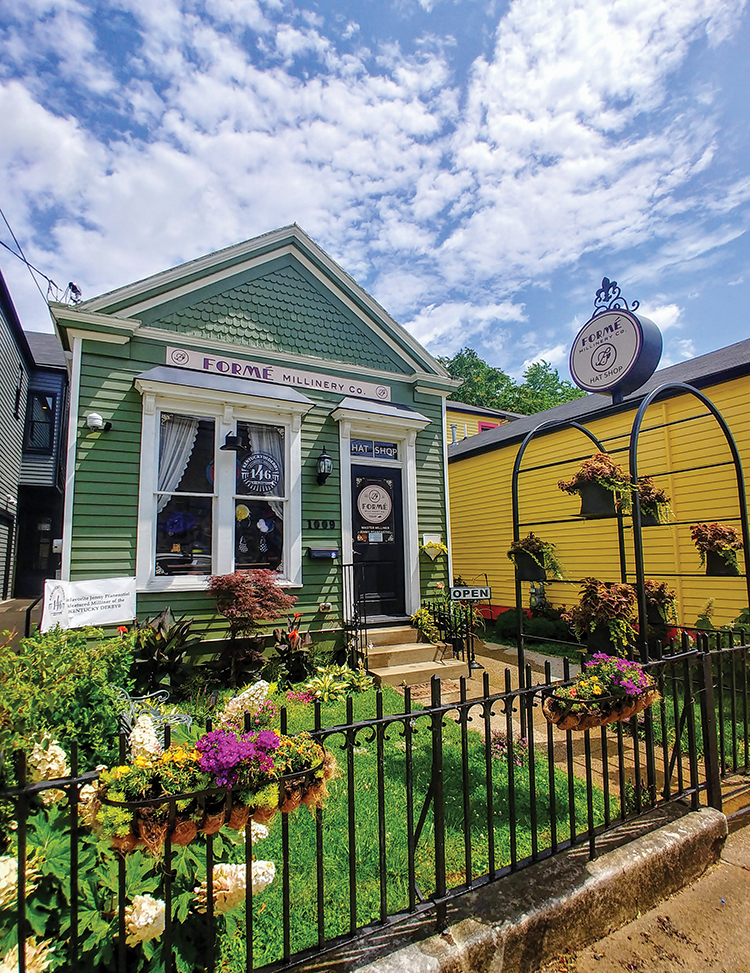
My hat shop is in a cottage that was built in 1877 and was converted from a single-family home to a storefront. I wanted the outside to be just as inviting as the inside and engage my visitors before immersing them in hats. Creating an experience for my customers was important to me. I didn’t want to just be another retail store. Visitors open the wrought iron gate and walk through the floral arch of top hat planters before walking through the front door and being greeted with French music. The walls are lined with handmade hats and vintage blocks. You will also find little mementos, things that I have collected all my life that remind me of my life’s adventures.
My shop is a museum of sorts, surrounded by century-old braid machines, hat blocks, hat stretchers and handmade trims from France. This is my safe place to let go and create freely while being surrounded by artifacts that inspire me to continue the craft of millinery and to pay homage to the people who worked in this industry before me.
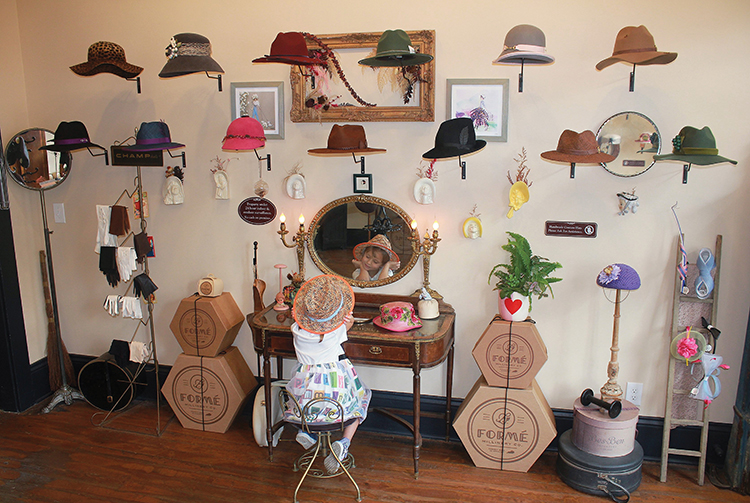
On any given day (when not in school), you can find my daughter, Amelia, who is 7 years old, at the hat shop. Some people have shop pets; I have my daughter. She loves hats and enjoys learning to sew and sculpt feathers. She is Mommy’s little helper when she is not playing dress-up or having a hat show.
“Fearlessly pursue your dreams. Embrace your ambitions.”
— Tory Burch
Since moving to Kentucky eight years ago, I have been named a Featured Milliner of the Kentucky Derby and the second milliner to be featured by Churchill Downs in 148 years. When I am not busy making Derby hats, I am creating hat collections for Vineyard Vines, J. Peterman, Keeneland and Woodford Reserve, to name a few.
I am also a hat designer for McCall’s Patterns and the author of the book The Making of a Milliner. My husband, Bart, and I also started a hat box company called Hat Boxes USA. Five years ago, the box company I used went out of business, and I couldn’t find the size or quality boxes I needed, so we worked with a packaging company and created three box templates. We now sell our hat boxes on Amazon, Wayfair and through our website.
One and a half years ago, Bart and I acquired a millinery supply company (yes, during a pandemic). The owner started Judith M Millinery Supply House 30 years ago and was ready to retire. She knew Bart and I were heavily involved in the hat world and asked if we would be interested in continuing her legacy. Judith M was one of three millinery supply houses left in the USA, and we couldn’t see it end. So, we agreed to take it on and move it to Kentucky, open a retail store and make it grow from there.
We kept the name and website since the name was well known. We provide supplies not only for milliners like me but to movie production houses, theater companies and universities to make hats for the projects they are working on. Some of the latest movies feature hats made using our materials. How cool is that?
As entrepreneurs, we are always thinking ahead, but right now, we are just one big happy hat family!
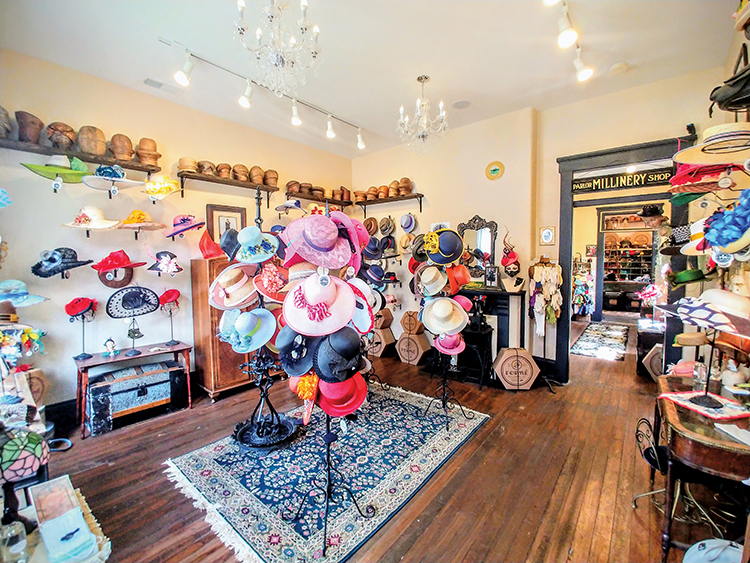

Never would I have imagined 14 years ago that sitting in my basement in Chicago making hats as a hobby would lead me to where I am today. It all started when I was 5 years old, when my mother taught me how to cross-stitch. Growing up, she sewed everything for my sister and me, from the clothes we wore to the dolls we played with. In high school, I lived in a tiny mountain town in Colorado and became great friends with a woman who was from England who made costumes for the local theater. She taught me so much about wardrobe construction and to not be afraid to experiment with materials and techniques in my work. This led me to study fashion design at the Colorado Institute of Art in Denver.
As a young girl, I was a ballerina, and I loved the idea of making costumes for the ballet. I did this for a couple of years, then decided it was time for me to move on to other experiences. After graduating, I packed up and moved to Chicago, where I created costumes for Cirque du Soleil, movies and commercials — and even a Grammy dress for Margaret Cho. I loved what I did, but I knew something was missing. One night, I was attending a lecture where a woman was talking about an age-old technique of blocking hats where she molded material over old wooden hat forms. Being an old soul myself, I loved how things were made years ago, and I wanted to learn more.
I ended up visiting Australia, where I learned the traditional techniques of hat making. I was immediately hooked, and because I knew how to hand sew, it came quite naturally. I started collecting old hat blocks that were used to hand-make each hat, many of them dating back centuries. Part of what intrigued me about the hat-making process was collecting the old blocks. When working with them, I loved thinking about the many hands that once made a hat on that exact block: What type of person were they? Where were they from? I thought about their energy coming through the blocks and being a part of each hat.

Making hats has always been about a feeling and never about just going through the motions to whip out a hat. From blocks, I started experimenting with sculpting hats. One fun fact about me is: I do not draw my designs. I find the best way for me to communicate and create what is in my head is to work with a material in my hands, forming it and allowing it to become what it wants. Never forcing an angle or shape. This allows me to create truly one-of-a-kind pieces, which my clients love.
Through my exploring, I am always keeping an eye out for old hat-making equipment and purchased a straw braid machine from the 1800s. This machine was typically used to create basic straw braid brimmed hats, though it operates very differently than your regular sewing machine. Because I was unfamiliar with how to traditionally use the machine, I started experimenting with the way the braid would sew together.
One day, I started to move my wrist and fingers as the braid was sewing together. I immediately noticed the shape change, and as I moved my wrist more or my fingers a different way, the braid moved in a different direction. I knew that I had just created something different, and thus my sculptural braided hats were born, something I have become known for throughout the world.
Let’s step back about 10 years, when I was living in Chicago. I owned a beautiful row house from 1883 with original stained-glass windows and pocket doors. I was creating hats in my basement and had transformed my dining room into a showroom where my clients would come to visit. While selling my hats at a local art fair, I met the woman who had a booth next to me who was from Kentucky. She asked if I ever thought of making hats for the Kentucky Derby. I hadn’t, so she invited me to stay with her during the Derby the following year and sell hats. I made appointments with several boutiques and sold hats from the trunk of my car. I sold out in one day and thought, “WOW: People really like hats here.”
Every year, I visited Kentucky during the Derby and rented a hotel room for two months. I would bring all my blocks and sewing machines and create hats to sell at hotels and boutiques. During this time, I fell in love with the town. The people were so nice, and I was amazed with how supportive the town was for small businesses, very different from a big city. So, once again, I packed my bags and moved to Louisville, Kentucky — this time with my husband, Bart. My goal was to have a storefront and get my hat studio out of our home. I found a 200-square-foot art studio that was among other artist studios.
I remember being so worried that I had rent to pay on a space, but I knew this was my time to run with my talent and create a name for myself.
Quickly, I grew out of my first art studio and rented something bigger in the same complex. Thinking about how many hats I must sell in a month to pay the higher rent was always lots of pressure. I made a commitment to myself that I was not looking back, and I would do whatever I needed to make this work. This was my passion, and I was confident that if I kept at it through the ups and downs, eventually I would make a living doing what I love. It was also wonderful having Bart, who was so supportive and a partner who believed in me. After five years in the art studio, I ended up moving to my very own storefront that was 1,700 square feet. I have now been here three years.
“In order to be irreplaceable, one must always be different.”
— Coco Chanel

My hat shop is in a cottage that was built in 1877 and was converted from a single-family home to a storefront. I wanted the outside to be just as inviting as the inside and engage my visitors before immersing them in hats. Creating an experience for my customers was important to me. I didn’t want to just be another retail store. Visitors open the wrought iron gate and walk through the floral arch of top hat planters before walking through the front door and being greeted with French music. The walls are lined with handmade hats and vintage blocks. You will also find little mementos, things that I have collected all my life that remind me of my life’s adventures.
My shop is a museum of sorts, surrounded by century-old braid machines, hat blocks, hat stretchers and handmade trims from France. This is my safe place to let go and create freely while being surrounded by artifacts that inspire me to continue the craft of millinery and to pay homage to the people who worked in this industry before me.

On any given day (when not in school), you can find my daughter, Amelia, who is 7 years old, at the hat shop. Some people have shop pets; I have my daughter. She loves hats and enjoys learning to sew and sculpt feathers. She is Mommy’s little helper when she is not playing dress-up or having a hat show.
“Fearlessly pursue your dreams. Embrace your ambitions.”
— Tory Burch
Since moving to Kentucky eight years ago, I have been named a Featured Milliner of the Kentucky Derby and the second milliner to be featured by Churchill Downs in 148 years. When I am not busy making Derby hats, I am creating hat collections for Vineyard Vines, J. Peterman, Keeneland and Woodford Reserve, to name a few.
I am also a hat designer for McCall’s Patterns and the author of the book The Making of a Milliner. My husband, Bart, and I also started a hat box company called Hat Boxes USA. Five years ago, the box company I used went out of business, and I couldn’t find the size or quality boxes I needed, so we worked with a packaging company and created three box templates. We now sell our hat boxes on Amazon, Wayfair and through our website.
One and a half years ago, Bart and I acquired a millinery supply company (yes, during a pandemic). The owner started Judith M Millinery Supply House 30 years ago and was ready to retire. She knew Bart and I were heavily involved in the hat world and asked if we would be interested in continuing her legacy. Judith M was one of three millinery supply houses left in the USA, and we couldn’t see it end. So, we agreed to take it on and move it to Kentucky, open a retail store and make it grow from there.
We kept the name and website since the name was well known. We provide supplies not only for milliners like me but to movie production houses, theater companies and universities to make hats for the projects they are working on. Some of the latest movies feature hats made using our materials. How cool is that?
As entrepreneurs, we are always thinking ahead, but right now, we are just one big happy hat family!







